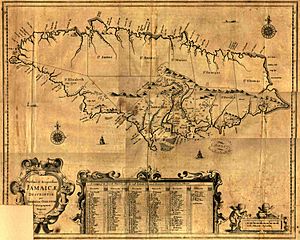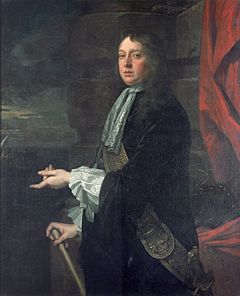Invasion of Jamaica facts for kids
Quick facts for kids Invasion of Jamaica |
|||||||||
|---|---|---|---|---|---|---|---|---|---|
| Part of the Anglo-Spanish War of 1654–1660 | |||||||||
 17th century map of Jamaica |
|||||||||
|
|||||||||
| Belligerents | |||||||||
| Commanders and leaders | |||||||||
| Strength | |||||||||
|
1,500 settlers | ||||||||
The Invasion of Jamaica happened in May 1655. It was part of the Anglo-Spanish War (1654–1660). During this time, an English army captured Spanish Jamaica. This invasion was part of a big plan by Oliver Cromwell. He wanted England to gain new colonies in the Americas. This plan was called the Western Design.
Even though major towns like Santiago de la Vega (now Spanish Town) were not well defended and were quickly taken, some people fought back. These were mostly escaped slaves, known as Jamaican Maroons. They continued to resist in the island's interior. The Western Design plan mostly failed. However, Jamaica stayed under English control. Spain officially gave up Jamaica in the Treaty of Madrid in 1670. The Colony of Jamaica remained a British possession until it became independent in 1962.
Contents
Why the Invasion Happened
In 1654, Oliver Cromwell and his government in England planned a surprise attack on Spanish America. There were several reasons for this. England's economy was not strong. Also, there were many unhappy soldiers from the recent Wars of the Three Kingdoms. Cromwell wanted to find a way to use them.
The English Expedition Begins
The English expedition left England in December 1654. It included 17 warships and 20 transport ships. They carried 325 cannons, 1,145 sailors, and 1,830 soldiers. More soldiers later joined from other English colonies in the West Indies, bringing the total to 8,000 troops. Admiral William Penn and Robert Venables were in charge. Venables was an experienced soldier who had just returned from Ireland.
Spain knew about these preparations since July. They ordered their defenses in Hispaniola to be improved. Spain correctly guessed that Hispaniola was the main target. The English fleet arrived in Barbados in January 1655. After two months of repairs, they sailed for Hispaniola.
Failed Attack on Hispaniola
On April 13, Penn landed 4,000 men under Venables near Santo Domingo. The soldiers suffered from illness. They were also bothered by local Spanish fighters, including black and mixed-race people. The attack on Santo Domingo failed. England lost 1,000 men. The English troops left Hispaniola on April 25.
Before this failure, Penn and Venables were already not getting along. Their relationship completely broke down after the failed attack. They had been given a lot of freedom to decide what to do next. Venables chose to try and save the mission by attacking Jamaica. He knew Jamaica was not well defended. However, Penn strongly disagreed with this plan. Venables even worried that Penn's fleet would abandon his men once they landed.
The Invasion of Jamaica

On May 19, two Spanish settlers saw Penn's fleet. They warned Governor Juan Ramírez de Arellano. The Spanish were surprised and quickly tried to prepare their defenses. One English participant later wrote about it:
On Wednesday morning, May 9th, we saw Jamaica Island, very high land far off. Wednesday the 10th our soldiers, 7000 in number, landed at the 3 forts...
At dawn on May 21, Penn's fleet entered Caguaya Bay. The bay was very shallow. Penn moved from his large ship, the 60-gun Swiftsure, to a smaller 12-gun ship called Martin. He led a group of smaller boats. Some of these boats, including the Martin, briefly got stuck in the shallow water. There was a short fight with a Spanish fort that protected the bay. A small number of settlers led by Francisco de Proenza, a local landowner, resisted. But they soon gave up.
Penn landed his soldiers, who quickly took Santiago de la Vega, about six miles away. Venables, even though he was sick, came ashore on May 25. He told the Spanish what the English demanded. Jamaica was now part of England. The Spanish people living there had to leave within two weeks, or they would be killed. After trying to delay, Governor Ramírez signed the agreement on May 27. Soon after, he sailed for Campeche, Mexico, but he died on the way.
Not all the Spanish people accepted this. Proenza moved non-fighters from northern Jamaica to Cuba. He then set up his base in the inland town of Guatibacoa. He joined forces with the Jamaican Maroons, who lived in the mountains. Their leaders were Juan de Bolas and Juan de Serras. They started a guerrilla war against the English.
What Happened Next
Penn left for England with half of the fleet on June 25. He wanted to tell his side of why the Hispaniola attack failed first. Venables followed him, arriving in England on September 9. He was very thin and sick. Just as they feared, Cromwell sent both of them to the Tower of London. They were released soon after, but they were removed from command. Penn's career recovered after the Restoration of the monarchy in 1660, but Venables' career ended.
The English soldiers left in Jamaica suffered greatly from disease and lack of food. Within a year, only 2,500 soldiers remained from the original 7,000. Spanish losses were also severe. One of the first victims was de Proenza, who lost his sight. Cristóbal Arnaldo de Issasi took over from him. Issasi's family had been among the first Spanish settlers.
When the English invaded, the Spanish freed their slaves. These freed people ran into the island's interior. There, they created free and independent communities as Maroons. Issasi was made Governor after Ramirez. He joined with the Maroons, led by de Bolas and de Serras. They tried to stop the English from taking control of the interior. Spain's attempts to take back Jamaica failed. They lost battles at Ocho Rios in 1657 and Rio Nuevo in 1658. After this, the English Governor, Edward D'Oyley, convinced de Bolas to switch sides. Without the Maroons' help, Issasi finally gave up and fled to Cuba.
Spain kept trying to get Jamaica back through talks. But they finally gave up the Colony of Jamaica and the Cayman Islands in the 1670 Treaty of Madrid. Under British rule, Jamaica became a very profitable colony. It produced large amounts of sugar to be sold.
See also
 In Spanish: Invasión de Jamaica para niños
In Spanish: Invasión de Jamaica para niños
- Horses in Jamaica
Sources
- Pestana, Carla Gardina The English Conquest of Jamaica: Oliver Cromwell’s Bid for Empire, Harvard University Press, 2017. ISBN: 9780674737310


